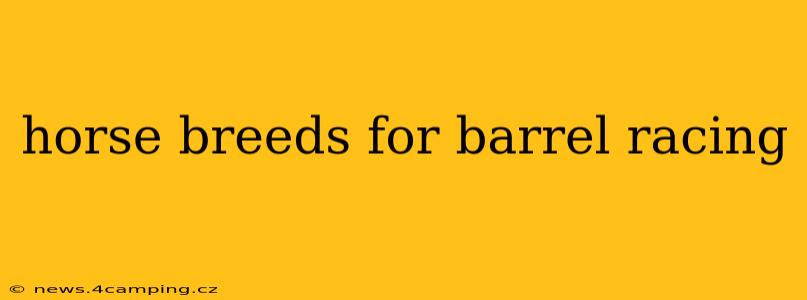Barrel racing, a thrilling rodeo event, demands a horse with specific qualities: speed, agility, quick reflexes, and unwavering stamina. While any horse can be trained for barrel racing, certain breeds naturally excel due to their inherent attributes. This guide delves into the most popular breeds, exploring their strengths and weaknesses to help you find the perfect equine partner for this exciting sport.
What Makes a Good Barrel Racing Horse?
Before diving into specific breeds, let's establish the key characteristics that make a horse ideally suited for barrel racing:
- Speed and Acceleration: The ability to rapidly accelerate and maintain high speed around tight turns is crucial.
- Agility and Maneuverability: Sharp turns require exceptional agility and the ability to change direction quickly and precisely.
- Athletic Build: A well-proportioned, athletic body is essential for both speed and maneuverability.
- Stamina and Endurance: Barrel racing is physically demanding; a horse needs the stamina to complete the run at full speed.
- Temperament: A calm, responsive, and courageous temperament is essential for a safe and successful partnership.
Popular Horse Breeds for Barrel Racing
Many breeds showcase the qualities needed for barrel racing success. Here are some of the most prominent:
Quarter Horses
Strengths: Quarter Horses are arguably the most popular breed for barrel racing. They are renowned for their exceptional speed, agility, and quick acceleration. Their naturally muscular build and sturdy conformation provide the strength and stamina needed for the demanding turns. Their calm temperament, coupled with their intelligence, makes them highly trainable.
Weaknesses: While generally robust, some Quarter Horses may lack the height and longer stride of certain other breeds, potentially impacting their top speed over longer distances.
American Paint Horses
Strengths: Closely related to Quarter Horses, American Paint Horses share many of the same desirable traits: speed, agility, and athleticism. Their striking coat patterns add visual appeal to the sport. Like Quarter Horses, they're known for their trainability and generally calm demeanor.
Weaknesses: Similar to Quarter Horses, height and stride length might be limiting factors for some individuals.
Appaloosas
Strengths: Appaloosas are known for their distinctive spotted coats and their exceptional athleticism and stamina. They often possess a strong work ethic and a willingness to please, making them responsive to training.
Weaknesses: While athletic, some Appaloosas might not possess the same explosive speed as Quarter Horses, and consistent training is essential to develop their full potential for barrel racing.
Thoroughbreds
Strengths: Thoroughbreds are celebrated for their incredible speed and stamina. Their long strides can be advantageous in covering ground quickly, especially on larger barrel racing patterns.
Weaknesses: Their high-strung nature can be a challenge for less experienced riders. Thoroughbreds often require experienced handling and consistent training to channel their energy effectively and develop the agility needed for tight turns.
Mustangs
Strengths: Mustangs, known for their resilience and athleticism, are increasingly popular in barrel racing. Their natural agility and stamina, honed by generations of survival in the wild, make them surprisingly adept at the sport.
Weaknesses: Mustangs often require significant training and desensitization to overcome their wild instincts and adapt to the demands of competitive riding.
H2: What size horse is best for barrel racing?
The ideal size for a barrel racing horse isn't a single number. A well-proportioned horse, regardless of exact height, will typically be successful. However, horses that are too large can struggle with the tight turns, while horses that are too small might lack the strength and power to maintain speed throughout the run. Most successful barrel racing horses range from 14.2 to 15.2 hands high.
H2: What is the best age for a barrel racing horse?
Many barrel racers prefer horses aged 5-10 years old. At this age, they are generally physically mature and have developed the necessary strength and coordination. Younger horses can compete but might require more time to develop their skills and stamina fully.
H2: What disciplines are similar to barrel racing?
Several disciplines share similarities with barrel racing, requiring speed, agility, and quick reactions. These include:
- Cutting: This requires quick turns and precise maneuvering to separate a cow from a herd.
- Reining: This involves performing precise maneuvers, including spins and sliding stops.
- Team Penning: This involves herding cattle into a designated pen, demanding quick maneuvers and precise timing.
Choosing the right horse breed for barrel racing is a significant decision. Carefully consider each breed's strengths and weaknesses, your riding experience, and your personal preferences to find the perfect partner to share in this exciting sport. Remember that training and the horse-rider bond are just as crucial as breed selection.
